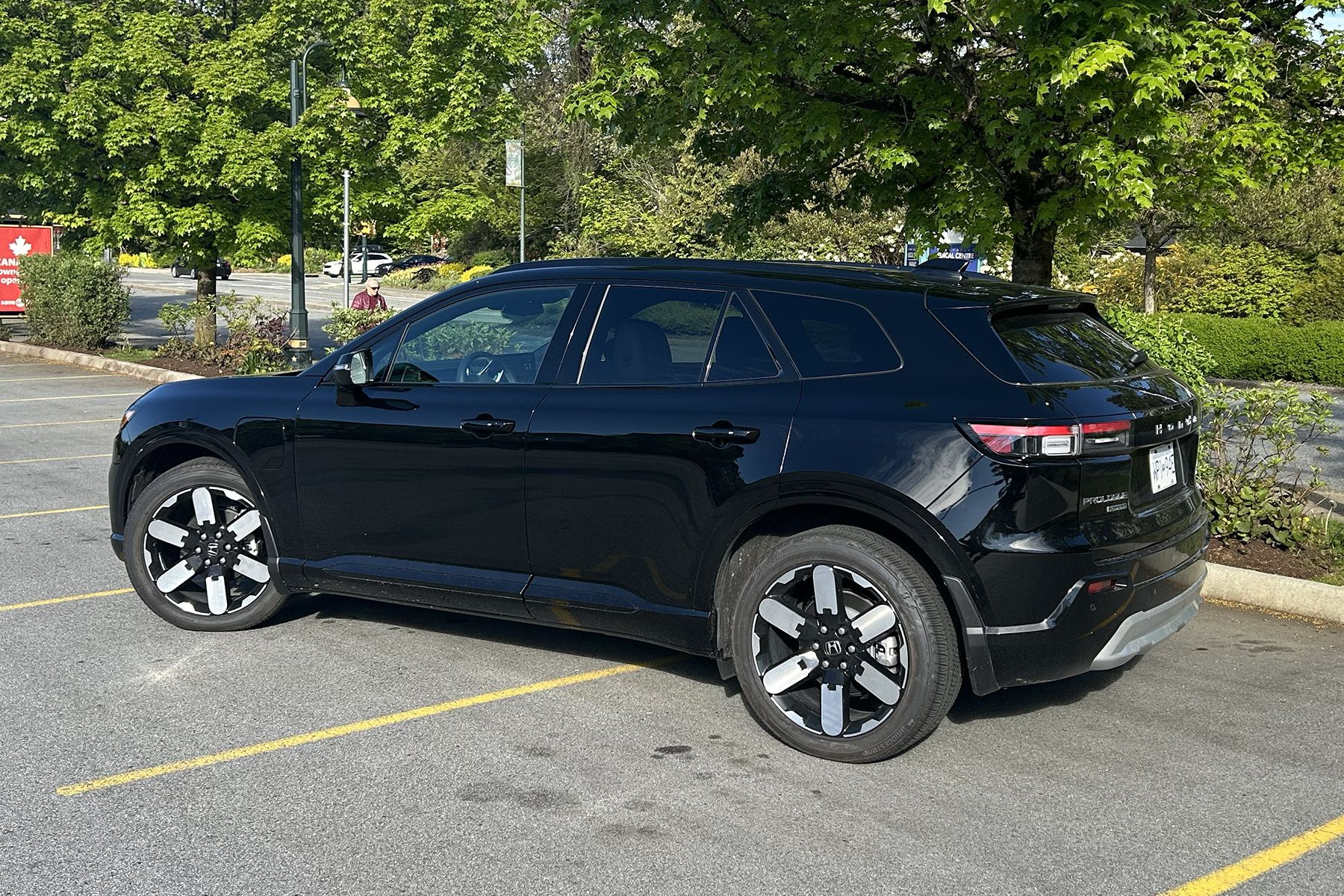Note
: This review vehicle is a 2024 model. The 2025 Honda Prologue gets more power — 12 horsepower and 43 lb-ft of torque — and between 16 and 21 kilometres more range depending on drivetrain.
Long-term Test Intro: Honda Prologue Touring
Much has been made about the joint venture between Honda and General Motors that produced a duo of all-electric vehicles badged, respectively, the Honda Prologue and the
Chevrolet Blazer EV
. Most of the chatter surrounded issues facing the shared GM Ultium platform that saw a stop-sale order on the Blazer EV due to software and charging issues. The Prologue had yet to go on sale at that time, so the damage was somewhat limited on Honda’s first-ever global all-electric vehicle. Notably, Honda has since stepped away from that partnership, with the Japanese automaker’s next wave of EVs designed and built in-house under the
0 Series
name.
I drove the 2024 Honda Prologue at the global first drive event in California
just over a year ago and was very impressed. Yes, it is an EV, but first and foremost it is a Honda, a brand that has been at or near the top of reliability and consumer satisfaction surveys for decades. Despite just having a few hours of seat time in the Prologue last February, I came away with a very positive feeling about it. It t just felt and looked like a Honda vehicle
— g
ood design inside and out, and all the controls were where you’d expect them to be. Nothing ‘EV-ey’ about it. Now I’ve got a 2024 Honda Prologue Touring for a three-month, long-term test, which will provide much more ‘living with it’ impressions, particularly when it comes to charging and range expectations.
What is the Honda Prologue?
An all-electric, mid-size crossover
, the Honda Prologue is sold only in North America, and in Canada just with a dual motor, or four-wheel drive, powertrain. Only a select number of Honda dealerships in B.C., Ontario and Quebec sell and service the Prologue. Shared parts with the Chevrolet Blazer EV include the frame rails, the floor, the front and rear suspension subframes, pedal box, steering column mounting, the base of the windshield, and firewall. Honda designers and engineers were responsible for the sheetmetal, and tuned the steering calibration, springs and dampers independently from the Blazer EV. There are also a few bits and pieces in the cabin that the two EVs share, such as the steering wheel and stalks, climate settings controls, door handles and locks, and window switches.
How much is the Honda Prologue?
There are three trims available, from the base EX through to the mid-range EX-L and top-of-the-line Touring.
Pricing ranges from $53,115 to $63,115, with my tester topping out at $73,986
(adding $300 black paint; $3,125 fees, freights and PDI; $571 protection package). The Touring trim adds several features, including a panoramic moonroof, leather-trimmed seats, a Bose premium audio system, and a power liftgate with hands-free access.
What is the range and power output of the Honda Prologue?
As mentioned, the all-wheel-drive 2024 Honda Prologue Touring uses GM’s Ultium platform, in this case fed by an
85-kWh liquid-cooled, lithium-ion battery pack producing 288 horsepower, 333 lb-ft of torque
and a
reported range of 439 kilometres
. A 11.5 kW onboard AC charger comes standard. One of the criticisms of the Prologue, and a justified one, is the DC fast-charging capacity of 155 kW, which is well below much of the competition. I expect to see a much higher charge rate in the next batch of Honda EVs. Honda claims a 10-minute DC charge will provide 99.7 kilometres of range — 54.9 km with a 240-volt, Level 2 charger — and I’ll be testing out both levels a number of times during my three-month tenure with the Prologue Touring. Look for the next instalment in early May where I’ll cover charging times.
EV charging – Everything you need to know
Early impressions of the Honda Prologue Touring
Jumping into the Prologue Touring for the first time since that first drive early last year, I was immediately reminded of why I had good vibes about the EV. In typical Honda fashion, the controls and screens are just where you’d expect them to be. All very intuitive to use and none of those frustrating, and distracting, submenus that so many all-electrics have that require for you to seemingly endlessly scroll to do something as simple as select a drive mode. And I love that all the climate controls are old-school buttons located under the infotainment touchscreen. All that said, one control I’m still getting used to just a few days into this long-term test is the gear selector. It’s a stalk mounted on the right-hand side of the steering wheel, and on a number of occasions I’ve moved it up and down to turn on the windshield wipers. Fortunately, it doesn’t go out of gear when you do this: a friendly message on the driver info screen informs you that you need to be stopped to go into park or reverse. Further confusion comes from the fact that said windshield wiper controls are on the stalk on the left-hand side, which doubles as the turn indicator control. This has also led to some misfires. To work the wipers there are toggle-like switches on the stalk. The advantage of the gearshift on the steering wheel is that it provides more space in the centre console, but I’m not sure if this is a good design.
Something else I’m getting used to is the sheer size of the Prologue. It’s billed as a mid-size crossover, but it feels larger. In a tight grocery store parking lot, I really had to rely on the backup camera when backing into a spot. The benefit of that size is the spacious cabin and rear cargo hold. Unlike many EVs, there is no frunk in the Prologue.
Long-term Test Update: Honda Prologue Touring
We’re a month-and-a-half into our long-term test of the 2024
Honda Prologue
Touring, and as I delve deeper into different uses and the submenus, I’m struck with one major takeaway: this might very well be an EV, but at its core the Prologue is a
Honda
. By that I mean most everything about the Japanese automaker’s first mass-production electric vehicle is logical. Controls are in the right places. The infotainment system is easy to navigate. Instructions are simple and straightforward. And the cabin is a study in form following function. This kind of formula has been the bread-and-butter of Honda for decades, and underpins the impressive sales record of models like the
Civic
and the
CR-V
. It’s encouraging to see that carried over to the company’s burgeoning EV stable.
The
Prologue was built in partnership with General Motors
, with the General’s version the
Chevrolet Blazer EV
. Both models share GM’s Ultium EV architecture. I recently took part in the global
first drive of the hotted-up Blazer EV SS
in North Carolina, which included some track time in the performance-oriented EV. That experience certainly demonstrated that the Chevy is tuned and trimmed much differently than the Prologue, but in the end my drive in the Blazer EV SS just underscored the strength of the Honda EV. And that is a very civilized, comfortable demeanor which translates to an ideal electrified mid-size SUV family hauler.
Speaking of tuning, Honda engineers paid special attention to the Prologue’s steering system. GM vehicles are notorious for high steering ratios — meaning more turning of the steering wheel required to get around corners — and Honda engineers did their best to shorten the ratio. It’s still a little high for my liking, at 18:6, but it does feel a nimbler than the Blazer EV. And the Prologue’s turning radius of 12 metres (39.6 feet) is excellent for an SUV of this size.
That size is one of the selling points of the Prologue, as I’ve discovered after doing some road trips in the EV along with a couple of airport pickup runs.
Rear seat room is excellent, and the aft cargo bay is more than large enough to swallow luggage for four adults on a weekend getaway or camping trip
.
One quibble I noted in my intro review of the Prologue Touring still bothers me. I haven’t been able to get comfortable with the gear selector on a steering wheel stalk. And now that I’ve lived with the Prologue for several weeks, the rear window is a little too small in my opinion. One of the selling features of a mid-size SUV is great visibility, and the view through the rearview mirror just doesn’t really cut it.
Charging up the Honda Prologue Touring
As I’ve noted in past long-term tests of EVs, the fact that I need to charge the vehicle a few times over the course of the test lends itself to a much better understanding of charging than just having the vehicle for a week and charging up just once. I’m happy to say I have had no issues whatsoever charging up the Prologue on Level 2 and DC fast-chargers. I’ve had a number of EVs that just wouldn’t ‘communicate’ with a nearby Petro Canada fast-charger, but no problems with the Prologue. Charge times seem to be as advertised, though I have yet to get close to Honda’s claim that a 10-minute DC charge will provide just under 100 kilometres of range. The closest I’ve got in 10 minutes is about 60 km, though of course this is due to the charge coming out of the charger, not the vehicle itself. Sort of underscores because we should all take automaker’s claims of charge times with a healthy pinch of salt.
As noted in the intro columns, the Prologue’s
fast-charging capacity of 155 kW is below some of the competition
, but that is rather a moot point since the maximum output of the chargers I have used is 150 kW. The location of the charge port on the right front fender is a good location, working nicely with all the chargers I have plugged into. I also put to use the supplied Level 1 charging cable, plugging it into an outlet in my driveway and overnight charging. Super slow as expected but still adds about 20 per cent range during that overnight charge. Many new EVs do not come with a cord to do this, and some can’t even accept a 120-volt charge, but I always consider having it a good back up, particularly on road trips. If you are visiting a friend, you can plug in at their place and at least get some additional range overnight.
Also as mentioned earlier, I really appreciate the simplicity of the infotainment interface, and this is particularly appreciated when it comes to charging. Too many EVs make scheduling a charge time a reach-for-the-owner’s-manual moment, but the Prologue’s system is dead easy to use, with easy to follow and intuitive instructions. There are so many real and perceived barriers to EV adoption, and Honda has done a great job of making such interactions with the Prologue very easy.
What others think of the Honda Prologue Touring
Another positive aspect of doing a long-term test of an EV, well, actually any new vehicle, is you get more opportunities for family members, friends and colleagues to take a ride, meaning good opportunities for opinions outside of automotive journalists. Most everyone who has sat in the passenger seats, up front or in the second row, have had positive things to say about the Prologue, particularly when it comes to comfort, space and the overall experience. But there is also a consistent criticism that the Prologue is kind of boring and plain. Apart from the Star Trek Enterprise ‘hum’ of the vehicle up to 35 km/h, they say it just doesn’t feel like the future, which is, after all, they note, is what an electric vehicle should be.
Interesting perspective for sure, but to my mind the Prologue represents an important milestone along the electric vehicle highway: a mainstream EV, without so many of the ‘oddball’ trappings the first and even second generation of 21
st
Century EVs displayed. And it should be pointed out that the perennial best-selling Honda Civic has had its fair share of scorn for being vanilla and boring yet still has repeat customers coming back for more. All of which, in the case of the Prologue, it seems somewhat ironic that Honda’s next mass production EVs, based on the
0 Series concept
, will embrace and even celebrate some ‘oddball’ traits and design cues.
Long-term Test Warp-up: Honda Prologue Touring
I recently complimented Ford for
assigning names like Expedition and Explorer to their SUV models
, as those names really do reflect the nature and user-case of those vehicles. While Prologue doesn’t necessarily conjure up the same kind of visceral connection as those Ford monikers, it certainly serves as the perfect model name for Honda’s first-ever, mass production electric vehicle. A prologue is “any act or event serving as an introduction,” and if this mid-size SUV is an indication of what is to come from Honda in the way of EVs, we’re in for some very competent and exciting all-electrics from the Japanese automaker.
That’s my main takeaway after spending the past few months a 2024 Honda Prologue Touring model. Words like competent and exciting have long been associated with this automaker — think the reliable Civic and racy S2000 — and while the Prologue leans a little more to the former description than the latter, there are definitely exciting things afoot with Honda’s all-electric program, which I witnessed firsthand on a
factory and tech tour at its R&D facility the Japanese industrial city of Tochigi
. These include innovative and cost-saving production techniques. But for now, until the next all-new Honda EV debuts, the Prologue is the flagship for the company’s all-electric aspirations. Here are some more final thoughts after my extended road test.
How efficient is the 2024 Honda Prologue Touring?
I drove 2764.1 kilometres during my time with the Prologue, and according to the on-board consumption computer, I traveled 4.6 kilometres for every kWh used. Calculating using the simple formula to get the kWh/100 km — the EV equivalent to L/100km and MPG — the efficiency rating of the Prologue was 16.6 kWh/100km. (For the math nerds out there, to get that number you take the energy used, in kWh, divide by the distance driven, then multiply by 100.) That 16.6 kWh/100 is certainly on the low side of the competition, and in fact on any EV segment, and with the majority of my kilometres traveled being city , that number is even more impressive. As I noted in the midway update story to this long-term test, the Prologue shares most of its mechanical and electrical workings with the
Chevrolet Blazer EV
, meaning the Honda uses GM’s Ultium batteries and architecture. Yes, the Ultium system did have some serious teething pains in its early days, but those have been resolved and the excellent efficiency of the Prologue during my time with it reflects how good the architecture is. That Honda-GM EV relationship is now over, or at least paused, so the next Honda EV, a sedan, will have architecture, motors and batteries built and/or sourced by Honda alone.
Can you plug the Honda Prologue into a Tesla supercharger?
Yes, according to Honda Canada, as of this summer Prologue and
Acura
ZDX owners will be able to purchase a Honda-approved NACS to CCS DC fast-charging adapter. This means this opens up charging opportunities to more than 22,000 Tesla Superchargers across North America. When available, the new adapters can be purchased from authorized Honda and
Acura
dealerships in Canada. No word on cost yet, but the adapters are currently available to U.S. customers at a price of US$225. According to Honda, Prologue and
Acura ZDX
owners will be notified via the HondaLink and Acura EV apps when adapters are available to purchase and, at that time, they will also be able to use the apps to locate authorized Supercharger locations. Honda has estimated that by 2030, Honda and Acura EV owners will have access to approximately 100,000 DC fast-charge points across North America, including the Tesla Supercharger network, all-new IONNA DC fast-charging network and the EVgo and Electrify America charging networks.
EV charging – Everything you need to know
Final thoughts on the 2024 Honda Prologue Touring
First off, thanks to Honda Canada for providing the 2024 Honda Prologue Touring for this long-term test. As I’ve said every time I do a long-term EV test, living with an EV longer than the typical one-week press vehicle time period provides much greater insight, and real-world experience, into the range, charging and efficiency of an all-electric vehicle. That certainly proved the case with my experience with the Prologue Touring. It demonstrated the strengths of this electric SUV, and its warts, as documented in my mid-term update. Competition in this segment is pretty fierce, and with each passing month or so an all-new EV SUV debuts. Some of those include the aforementioned Blazer EV, the
Tesla Model Y
, the
Kia EV6
, the
Ford Mustang Mach-E
and the
Hyundai Ioniq 5
. Of all of these, the Honda Prologue and the Blazer EV are the most ‘traditional’ SUVs in terms of layout and body style, and while those other competitors each offer aspects that better the Prologue in terms of range, charging and styling, the Honda does what Hondas have been doing for decades now. Reliable, competent, and yes, even a little exciting.







